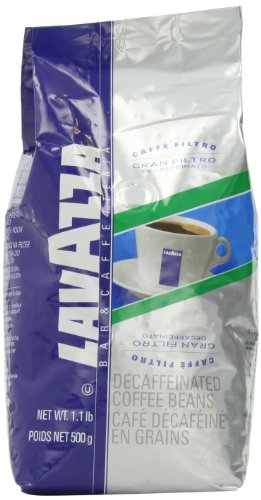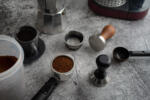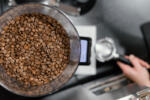Everyone loves an Espresso at the beginning of a long day or even during a long tiring day. You must have been in a place where you wanted a great cup of espresso at home, but it didn’t seem reasonable to invest in an expensive machine.
You should know that there is a way to make a perfect cup of espresso-like at home without having to spend money on an expensive machine. The Moka Pot is a traditional, economical utensil that can brew great cups of espresso-like coffee at home or anywhere with a stove.
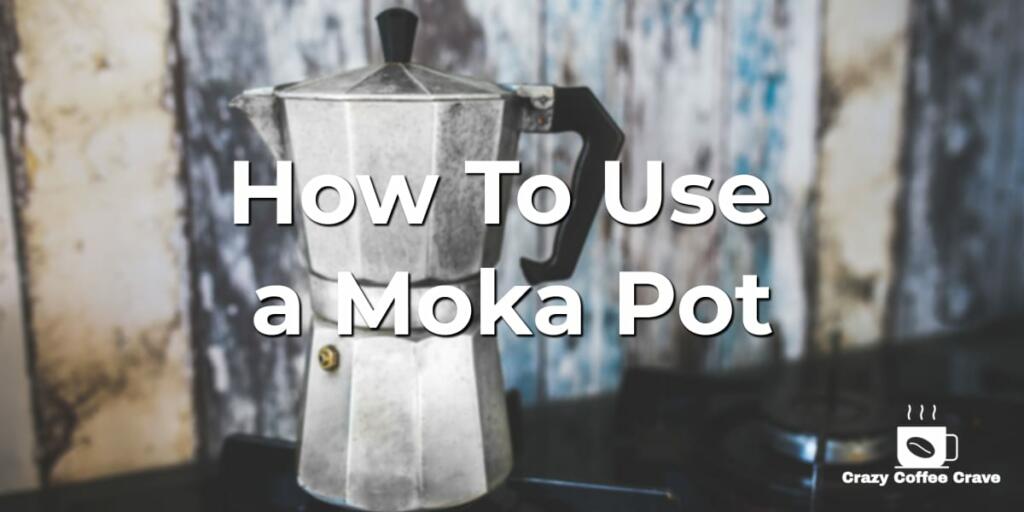
What makes the Moka Pot incredible is that it makes coffee similar to espresso but with a lighter tone. However, the strength is greater than what you would get with a drip coffee maker, so the Moka Pot does its job fine. You can make a perfect cup of coffee that is neither too strong nor too light.
The in-between strength gives out the middle flavor and vibe. The Moka Pot brews 2-3 times stronger than a regular drip coffee maker, so it is safe to say that it does the job as close as an espresso, satisfying your craving. So, it combines the traditional warm charm with the modern need for an espresso and brews a perfect hybrid.
The Moka Pot is known to be famous in Italy and is literally on every other house. However, it is not famous due to its beautiful design and affordable price. Its popularity is the simple method of brewing a great cup of coffee.
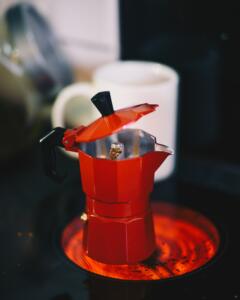
What is a Moka Pot
In today’s world, modern high-tech espresso machines and drip coffee makers are seen everywhere. However, people still have not gotten over brewing a cup of coffee the old-fashioned way. Since the introduction of the Moka Pot in the 1930s, the espresso maker is still in use at homes and cafes to brew delicious and marvelous cups of coffee worldwide.
Before we move on to making the perfect cup of coffee using Moka Pot, let’s look at what it is made of. Knowing this will help you understand the design. Consequently, you can make a better cup of coffee, knowing the machine’s whereabouts. The Moka Pot has four main components:
- Bottom Chamber: the water is held in the bottom chamber, then boiled to a good 100 degrees before adding the coffee.
- Top Chamber and Tube: This is the part where the coffee is collected after it has been through the brewing process.
- Tube and Basket: The basket is located above the bottom Chamber (with grounds in it), which is joined to the lower Chamber with a tube providing a passage for the water to go down and reside
- Filters: Moka Pot has two filters in total. One filter is located in the basket, and the other is in the top tube.
How to use a Moka Pot coffee maker
A rule of thumb says to use grinds that are slightly finer than grinds used for drip coffee makers but are coarser than grinds used in an espresso coffee machine. The middle ground grinds are recommended for a perfect brew in the Moka Pot due to how it is designed.
Making coffee in a Moka Pot is no rocket science, but there is no exact method that gives you the perfect cup of coffee. The reason is that everyone has their preferences, so you would have to go through a hit-and-trial process until you find the perfect brew for yourself.
However, this guide will make your journey far easier and less time-consuming.
It is suggested to start with grounds less than 250 grams and then experiment from there. Making espresso in a Moka Pot is efficient and beautiful in its simplicity. However, the magic of the peroccurskes occurs due to pressure and heat. All the four main parts mentioned above play a vital role in these.
The Moka Pot uses steam pressure to force the water through a filter. First, the water is filled in the bottom chamber of the pot, and in the middle, the fine-grind coffee is placed in a filter above it. Then heat is provided that generates steam. The steam forces water above the filter, resulting in a strong shot of coffee.
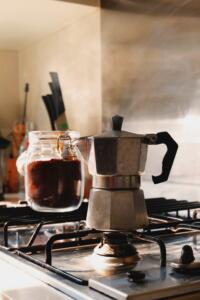
Here is a step-by-step guide for the whole process:
- Step 1 – Add water to the Moka Pot
Fill water in the lower Chamber precisely below the valve. Ensure the water is cold and doesn’t overfill, as overfilling will water-log the coffee and impact the flavor.
- Step 2 – Grind the coffee beans.
This step requires consistency as the more consistency of the grind, the better the coffee. Next, grind the beans until enough product fills the funnel with coffee. Grinding can be done at home, or pre-ground coffee can be bought directly. Ensure the grind is not extra fine because it will clog the Moka Pot.
- Step 3 – Add the grind to the Moka Pot.
Put the funnel in the Moka Pot and fill it with ground coffee. Make sure to clean the edges of the funnel before starting the process. It is also important to avoid overfilling the filter with excess coffee and avoid tamping it because it creates pressure inside.
- Step 4 – Get ready for the remaining Moka Pot.
Now comes the part where the rest of the Moka Pot has to be prepared. First, make sure you tightly screw up the upper part onto the pot’s base. Be gentle and delicate while screwing the Pot, and make sure you don’t hold it by the handle, as it is quite fragile when applying pressure.
- Step 5 – Put it on Fire!
This step requires some attention to detail. Here you have to choose a burner that exactly fits the bottom of the Moka Pot. If you are using a gas stove, make sure that the flames don’t go around the sides of the Pot. Once you have found the perfectly sized burner or stove, put the Moka Pot on it.
Let it stay on until the water starts to boil. When the boiling starts, wait till the coffee starts coming out of the center post. You should make sure that the heat is slow and not too quick and intense. You need to heat the Pot slowly to get the best results out of it. Better extraction happens if heat is provided slowly. Too intense heat will cause the coffee to pour out, which will have a burnt taste.
- Step 6 – Checking and Stirring
This is the step where you have to check when the top of the Pot is full of coffee and hazel brown foam can be seen out of the spout. The foam is an indicator that tells that the coffee is almost made. So, the second you see it, know your coffee has been brewed. Before putting it in a cup, it is optional to stir the coffee slightly.
- Step 7 – Time to Serve
You have done a great job, and near to a perfect cup of coffee has been brewed. Now put it in a fancy cup and enjoy the wonder you just did.
Common challenges you might face with a Moka Pot (stovetop espresso)
Brewing with a Moka pot comes with some special but not insurmountable challenges. Below are some of the pitfalls you might encounter before nailing the perfect coffee routine, plus tips on preventing them.
If you made weak coffee
Over-extraction can make your coffee weak. So that means you must mainly apply the opposite techniques to some of those mentioned below. You may want to raise brew time or go for finer grinding. Often, double-check whether the grounds are uniformly distributed in the coffee bag.
Bitterness from the Moka Pot coffee
Coffee bitterness is a common complaint across various brewing methods and is often a product of over-extraction. Over-extracting the coffee means exposing the beans to too much hot water or brewing too long, allowing the flavor to degrade.
If you have trouble brewing in time, there are a few different things you can try:
- Preheat water. This will raise your Moka pots actually on the burner.
- Reduce brewing time. Spend less time brewing the coffee to see if it makes it lighter
- Grinding your coffee. Your grind matters; if you find things leaning bitter to your taste, try coarse your grinds to minimize surface area and slow extraction.
- Decrease heat exposure. You can brew too hot; try using lower heat on your stove.
Your Moka Pot is leaky
One of the problems you might find is a leaky pressure release valve. The system has built up too much pressure when steam begins pouring out of the valve. This problem may be from a few reasons:
- overstuffed coffee chamber,
- compressed (or tamped) grounds,
- or too much heat.
When you find a leaky valve, remove your Moka Pot from the heat and try to change your ground to prevent pressure build-up.
Top Coffees to make in a Moka Pot
Choosing the right can make a huge difference when brewing in a Moka Pot. Here are the three best:
- A First, 5-pound bag of Sulawesi Kalossi (Whole Bean Coffee) is an excellent option if you are looking for a strong and full-bodied dark roast coffee. In addition, the coffee has low acidity, which enables it to produce excellent results in a stovetop coffee maker.
- At times when you are in the mood for a decaf, then the best option to go for is Lavazza Gran Filtro Decaffeinated – Whole Bean Coffee. This coffee offers and sweet, intense, and smooth flavor when made on a stovetop coffee maker.
- If you are looking for something you can use daily, then go for Lavazza Qualita Rossa Ground with your Moka pot. This coffee offers a naturally sweet flavor and strong coffee that will do the job for you.
Things to consider when buying a Moka Pot
- Your lifestyle is the first thing to consider when making a Moka Pot purchase. Ask yourself if you need a Moka Pot for your Kitchen in a home or apartment. If yes, some classic options like Bailettis and Cuisinox will do the job for you. On the other hand, if you need to make a purchase for your dorm room or coffee on the go, go for the Tops model or De’Longhi’s Alicia.
- The second thing to consider is the material. Moka Pots come in two different materials: Aluminum and Stainless steel.
- Aluminum
The first thing to know about aluminum is that it rusts if it is not left completely dry. Moreover, aluminum-made Moka Pots are a bit high maintenance. Another thing to worry about is checking the electric stove compatibility. Aluminum is also harmful to the dishwasher. However, given all the drawbacks of aluminum, the Moka Pots will still last you quite a few years before they start to die out.
- Stainless Steel
Stainless Steel is the real deal as it is non-corrosive, non-porous, and extremely durable. This can last you a lifetime, providing great coffee throughout. The only downside to stainless steel is that it is comparatively more expensive than aluminum, which can last around a decade. On a better note, they are easier to wash and clean and are low maintenance.
So, if you are in the market to save money but can afford high maintenance, go for aluminum. On the contrary, if you are ready to spend money and avoid high maintenance, then stainless steel is the road you should take
- The cup size. It is also vital to keep in mind the size of the Moka Pot. A six-cup Moka Pot can get comfortably brew enough coffee to accommodate about two regular espresso drinks. If you require more than that, you can always size up the cup.
What’s the best Moka Post?
Bialetti 06800 Moke Post
- The design is classic and recognizable
- Bialetti’s patented design
- Sizes ranging from 3 to 12 cups
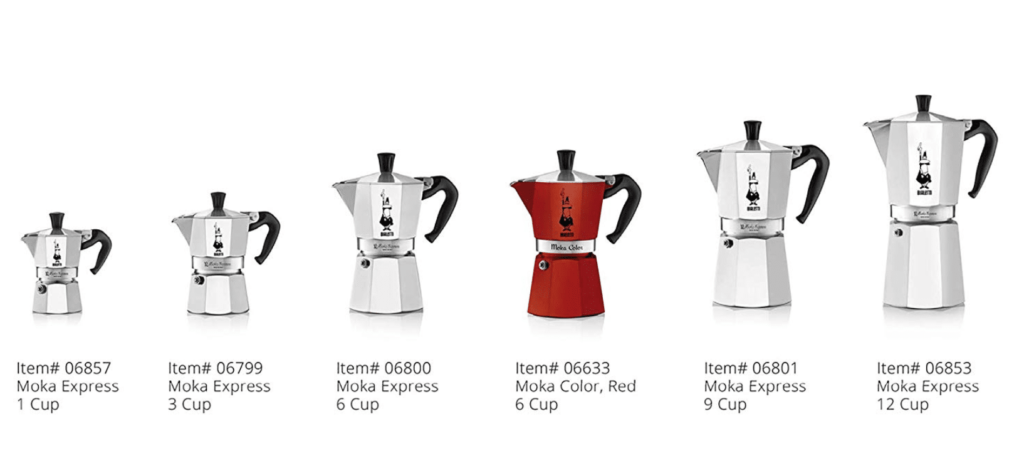
How to clean a Moka Pot
Making the perfect cup of coffee from a Moka Pot requires many things to be followed, and keeping the Pot clean is one of them. To clean the Pot, you will need the following things:
- Moka pot
- Warm water
- Soft cloth
Now follow these instructions to perfectly clean the Pot:
- First, dump the grounds: once you are done brewing and have poured all the coffee into a cup, let the Moka Pot cool off. After giving it ample time to cool off, dump the coffee grounds out of the basket.
- De-assemble the Pot: after taking out the grounds, take apart all the pieces of the Pot. Don’t forget to take out the basket and the filters.
- Rinse: Rinse each piece of the Pot with warm water. Make use of your fingers to get out any debris left behind.
- Dry: drying is important as water left behind on any piece may corrode the metal. You can use a soft cloth or air dry each piece separately.
- Reassemble: after you are done with the drying, put all the pieces together, and the Pot will be ready to brew a perfect cup of coffee.
What is the best way to clean a stainless steel Moka pot?
One part white vinegar and two parts cold water can be used to clean a stainless steel Moka pot. Turn the pot on and pour the water and vinegar into the basin. Next, make a full pot of tea and set it aside for 15 minutes. The pot should then be emptied and rinsed with cold water. For a quick clean, combine baking soda and cold water.
Frequently Asked Questions
How do you know when a Moka pot is done?
The water in the bottom chamber acts as an indicator. When it reaches the boiling point, the pressure will push a stream of coffee slowly through the upper Chamber. If water explodes upward, your water is too hot; if it burbles lethargically, turn up your flame. You will know it’s done when you hear a hissing, bubbling sound of water.
Can I use a Moka pot on an electric stove?
Yes, you can use a Moka Pot on an electric stove. It doesn’t heat like gas, but it works.
Can I use regular coffee in a Moka pot?
Regardless of the type or brand of Moka pot you’re using, if you don’t use the most appropriate coffee, your efforts to brew a perfect cup of espresso or full-bodied coffee will fail!
What size is a Moka pot for one person?
Moka Pots usually come in sizes: 1-cup, 3-cup, 6-cup, 9/10-cup, and 12-cup.
How much coffee do you put in a Moka pot?
Measure 25.5 g of coffee (3.5 tbsp) and grind to the consistency of table salt for the six-cup Bialetti Moka Pot.
Which is better French press or Moka Pot?
Moka pot or French Press? If you don’t like sharp-tasting coffee or espresso but want something more flavorful than a standard automatic drip, go for a French press. Those who prefer coffee with no sediment and a brew akin to espresso typically enjoy having a Moka pot.
Disclaimer: This post contains affiliate links, which means I may receive a small commission, at no extra cost to you, if you make a purchase using these links. Remember to support us by purchasing through the Amazon/Walmart/Impact Radius links provided. Last update on 2024-04-25 / Affiliate links / Images from Amazon Product Advertising API
Disclosure: No compensation or free products were received in exchange for writing this review.

Editorial Staff
The editorial staff at Crazy Coffee Crave is a team of coffee enthusiasts & Baristas who enjoy the one thing we all think about as soon as we get up in the morning. Trusted by thousands of readers worldwide.


